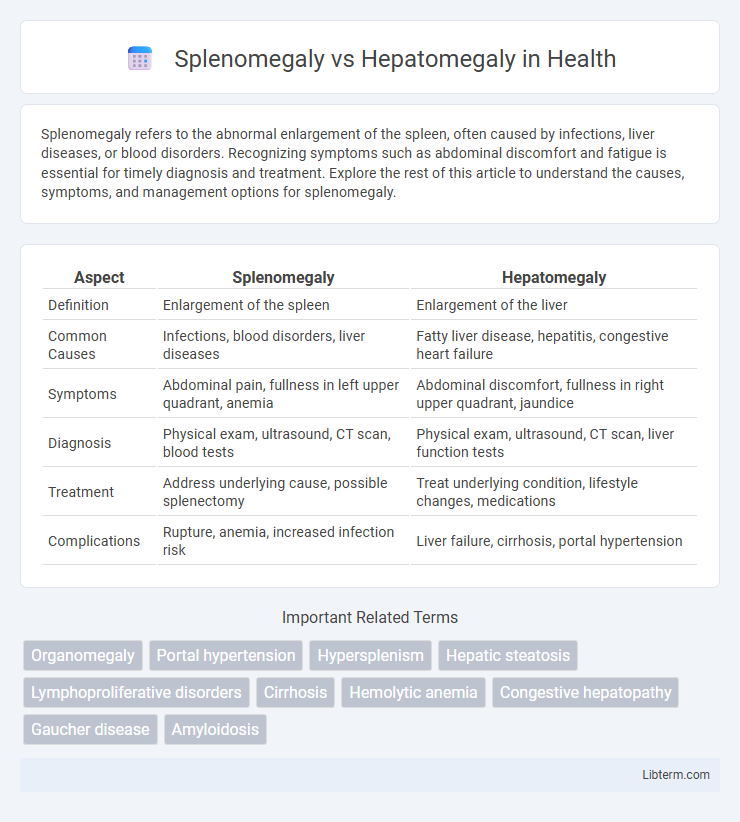Splenomegaly refers to the abnormal enlargement of the spleen, often caused by infections, liver diseases, or blood disorders. Recognizing symptoms such as abdominal discomfort and fatigue is essential for timely diagnosis and treatment. Explore the rest of this article to understand the causes, symptoms, and management options for splenomegaly.
Table of Comparison
| Aspect | Splenomegaly | Hepatomegaly |
|---|---|---|
| Definition | Enlargement of the spleen | Enlargement of the liver |
| Common Causes | Infections, blood disorders, liver diseases | Fatty liver disease, hepatitis, congestive heart failure |
| Symptoms | Abdominal pain, fullness in left upper quadrant, anemia | Abdominal discomfort, fullness in right upper quadrant, jaundice |
| Diagnosis | Physical exam, ultrasound, CT scan, blood tests | Physical exam, ultrasound, CT scan, liver function tests |
| Treatment | Address underlying cause, possible splenectomy | Treat underlying condition, lifestyle changes, medications |
| Complications | Rupture, anemia, increased infection risk | Liver failure, cirrhosis, portal hypertension |
Introduction to Splenomegaly and Hepatomegaly
Splenomegaly refers to the abnormal enlargement of the spleen, often caused by infections, liver diseases, or hematologic disorders, while hepatomegaly denotes the enlargement of the liver due to conditions such as hepatitis, fatty liver disease, or congestive heart failure. Both conditions are clinically significant indicators of underlying systemic diseases and require diagnostic evaluation through physical examination, imaging studies, and laboratory tests. Recognizing splenomegaly and hepatomegaly is crucial for timely intervention and management to prevent complications related to organ dysfunction.
Definitions and Anatomical Differences
Splenomegaly refers to the abnormal enlargement of the spleen, an organ located in the upper left quadrant of the abdomen responsible for filtering blood and immune response. Hepatomegaly denotes the enlargement of the liver, situated in the upper right quadrant beneath the diaphragm, playing a critical role in metabolism, detoxification, and bile production. The spleen is part of the lymphatic system, whereas the liver belongs to the digestive system, highlighting their distinct anatomical locations and physiological functions.
Common Causes of Splenomegaly
Splenomegaly, characterized by an enlarged spleen, commonly results from infections such as mononucleosis, bacterial endocarditis, and malaria, as well as hematologic diseases including lymphoma, leukemia, and hemolytic anemia. In contrast, hepatomegaly, or an enlarged liver, is frequently caused by liver-related conditions like hepatitis, fatty liver disease, and cirrhosis. Understanding the distinctive etiologies of splenomegaly aids in accurate diagnosis and targeted treatment strategies.
Common Causes of Hepatomegaly
Hepatomegaly refers to the abnormal enlargement of the liver, commonly caused by conditions such as hepatitis, fatty liver disease (non-alcoholic steatohepatitis), congestive heart failure, and liver tumors. In contrast, splenomegaly involves the enlargement of the spleen and is often linked to infections like mononucleosis, hematologic diseases, and portal hypertension. Understanding the underlying causes of hepatomegaly is crucial for accurate diagnosis and targeted treatment strategies.
Clinical Signs and Symptoms
Splenomegaly presents with left upper quadrant abdominal pain, early satiety due to gastric compression, and palpable enlarged spleen on physical examination. Hepatomegaly is characterized by right upper quadrant discomfort, jaundice, and a firm, enlarged liver detectable during palpation. Both conditions may show systemic symptoms like fatigue and weight loss, but specific signs help differentiate underlying etiologies.
Diagnostic Approaches and Imaging
Splenomegaly and hepatomegaly are diagnosed primarily through physical examination and confirmed using imaging modalities such as ultrasound, CT scan, and MRI, which provide detailed visualization of the spleen and liver size, texture, and lesions. Ultrasonography is the preferred initial imaging technique due to its non-invasiveness and ability to assess organ dimensions and vascular flow, while CT and MRI offer advanced characterization of underlying causes like tumors, infections, or fibrosis. Laboratory tests combined with imaging findings support the differential diagnosis by correlating organ enlargement with clinical conditions such as portal hypertension, hematologic diseases, or congestive hepatopathy.
Laboratory Findings in Splenomegaly vs Hepatomegaly
Laboratory findings in splenomegaly often reveal cytopenias such as anemia, leukopenia, or thrombocytopenia due to hypersplenism, along with elevated liver enzymes if associated with underlying liver disease. In hepatomegaly, laboratory tests frequently show elevated transaminases (AST, ALT), increased bilirubin levels, and altered coagulation profiles indicating liver dysfunction or damage. Both conditions may present with abnormal inflammatory markers, but specific patterns in liver function tests and blood cell counts help differentiate splenic enlargement from liver enlargement.
Complications and Health Implications
Splenomegaly often leads to hypersplenism, causing anemia, leukopenia, and thrombocytopenia due to excessive blood cell sequestration, increasing infection risk and bleeding complications. Hepatomegaly can indicate advanced liver diseases such as cirrhosis or hepatitis, which may result in portal hypertension, ascites, and liver failure with systemic consequences. Both conditions suggest underlying pathology requiring prompt diagnosis to prevent severe organ dysfunction and life-threatening complications.
Management and Treatment Strategies
Management of splenomegaly primarily involves addressing the underlying cause, such as infections, hematologic disorders, or liver diseases, often requiring targeted therapies like antibiotics, chemotherapy, or immunosuppressants. Hepatomegaly treatment focuses on managing liver conditions including hepatitis, fatty liver disease, or cirrhosis, using antiviral medications, lifestyle changes, and occasionally liver transplantation. Both conditions may necessitate supportive care measures like pain relief and monitoring for complications, emphasizing individualized treatment plans based on the specific etiology and severity.
Prognosis and Long-term Outcomes
Splenomegaly often indicates underlying hematologic or infectious disorders, with prognosis depending on the treatability of the root cause, such as lymphoma or cirrhosis-related portal hypertension, and may lead to complications like hypersplenism affecting blood cell counts. Hepatomegaly is frequently associated with chronic liver diseases like hepatitis or fatty liver disease, where long-term outcomes rely on preventing progression to cirrhosis or liver failure through lifestyle changes and medical management. Both conditions require ongoing monitoring for complications, but hepatomegaly-related outcomes are often more directly linked to liver function deterioration and potential development of hepatocellular carcinoma.
Splenomegaly Infographic

 libterm.com
libterm.com